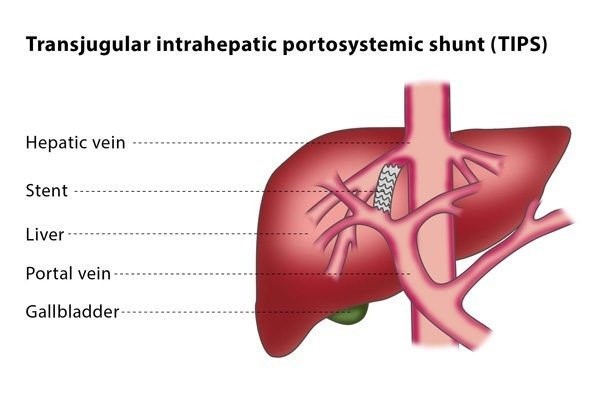
TIPS - Transjugular porto-systemic shunt: what it is, how it works and when it is performed
TIPS (Transjugular Intrahepatic Porto-systemic Shunt) or Transjugular Intrahepatic Porto-systemic Shunt is an interventional radiology procedure that creates a communication between the portal vein, or one of its major branches, and a suprahepatic vein, afferent to the systemic circulation
What is TIPS?
TIPS (Transjugular Intrahepatic Porto-systemic Shunt) or Transjugular Intrahepatic Porto-systemic Shunt is a procedure that is used to reduce portal vein hypertension (portal hypertension).
Portal hypertension is a pathological condition characterised by increased pressure in the portal vein, i.e. the vein responsible for transporting wasted blood to the liver from most abdominal organs and usually caused by the presence of an obstruction in the progression of blood.
How does TIPS work?
In the past, this procedure was performed by means of several surgical procedures.
Thanks to the advent of interventional radiology, it is possible to create a channel of communication between the portal vein and the vena cava by placing a metal stent (small tube-shaped metal prosthesis) through a catheter and under radioscopic and echotomographic monitoring, which drains part of the high-pressure blood in the portal vein directly into the venous circulation.
The entry of the catheters required for the procedure usually takes place through a puncture of the jugular vein (hence the name of the procedure), through which the interventional radiologist then reaches the right suprahepatic vein.
TIPS is generally performed under local anaesthesia following antibiotic prophylaxis
The first catheter to be inserted is the one used to inject the contrast medium, which allows the anatomy of the portal vein system to be studied by means of radiological control.
The second catheter, as a rule, is the one through which the stent is inserted, the purpose of which is to connect the two venous systems, thus reducing the pressure within the portal vein.
In the absence of complications, the hospital stay lasts no less than 4-5 days.
What are the pros and cons of TIPS?
The main positive aspect of this procedure is the containment of portal pressure.
The most frequent complication following the procedure is the occurrence of hepatic encephalopathy (in an estimated 5-35% of cases).
A worsening of liver function can also sometimes be observed.
Is TIPS painful and/or dangerous?
TIPS is a non-invasive procedure that is not burdened by the after-effects of classic surgery.
However, it is possible to experience abdominal discomfort, especially in the first few days of the post-operative course.
As for risks, the main one is stenosis of the inserted stent, a condition that requires rapid intervention to re-establish its patency and function.
Another potential risk is the development of hepatic encephalopathy (in 5-35% of cases), a condition characterised by the presence of confusion, disorientation and altered sleep patterns, which can most often be resolved with conservative medical treatment.
Who can perform the treatment?
Patients with severe portal hypertension and recurrent episodes of bleeding from oesophageal varices that cannot be controlled with variceal ligation (endoscopic procedures), with severe ascitic decompensation that does not respond to medical therapy, and liver transplant candidates, to reduce the complications of portal hypertension while waiting for the transplant.
Absolute contraindications to the placement of a TIPS are recurrent or chronic acute hepatic encephalopathy in patients who are not liver transplant candidates, total portal thrombosis, extensive hepatic neoplasms and severe renal or hepatic failure.
Follow-up
After undergoing this procedure, patients must be carefully monitored over time both by performing hepatic Echo-Colour-Doppler examinations (usually seven days after surgery, then after one month and then every three months for at least two years), and by angiographic examinations to check the pressure values in the portal vein and vena cava systems in order to monitor the proper functioning of the inserted stent.
Preparation standards
Admission usually takes place the day before the procedure.
Once admitted, the patient will have to take antiplatelet medication to prepare for the procedure.
If he/she is being treated with other medications, it will be a good idea to discuss with the doctor the continuation of current therapies.
Before undergoing this examination, the patient must have been fasting from solid food since midnight beforehand.
Read Also:
Emergency Live Even More…Live: Download The New Free App Of Your Newspaper For IOS And Android
Hepatitis In Children, Here Is What The Italian National Institute Of Health Says
Acute Hepatitis In Children, Maggiore (Bambino Gesù): ‘Jaundice A Wake-Up Call’
Nobel Prize For Medicine To Scientists Who Discovered Hepatitis C Virus
Hepatic Steatosis: What It Is And How To Prevent It
Acute Hepatitis And Kidney Injury Due To Energy Drink Consuption: Case Report
The Different Types Of Hepatitis: Prevention And Treatment
Acute Hepatitis And Kidney Injury Due To Energy Drink Consuption: Case Report
New York, Mount Sinai Researchers Publish Study On Liver Disease In World Trade Center Rescuers
Acute Hepatitis Cases In Children: Learning About Viral Hepatitis
Hepatic Steatosis: Causes And Treatment Of Fatty Liver
Hepatopathy: Non-Invasive Tests To Assess Liver Disease
Liver: What Is Non-Alcoholic Steatohepatitis
Hepatitis Outbreak In Children: 600+ Cases Worldwide, Cause Remains A Mystery


